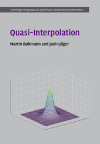- About MAA
- Membership
- MAA Publications
- Periodicals
- Blogs
- MAA Book Series
- MAA Press (an imprint of the AMS)
- MAA Notes
- MAA Reviews
- Mathematical Communication
- Information for Libraries
- Author Resources
- Advertise with MAA
- Meetings
- Competitions
- Programs
- Communities
- MAA Sections
- SIGMAA
- MAA Connect
- Students
- MAA Awards
- Awards Booklets
- Writing Awards
- Teaching Awards
- Service Awards
- Research Awards
- Lecture Awards
- Putnam Competition Individual and Team Winners
- D. E. Shaw Group AMC 8 Awards & Certificates
- Maryam Mirzakhani AMC 10 A Awards & Certificates
- Two Sigma AMC 10 B Awards & Certificates
- Jane Street AMC 12 A Awards & Certificates
- Akamai AMC 12 B Awards & Certificates
- High School Teachers
- News
You are here
Quasi-Interpolation

Publisher:
Cambridge University Press
Publication Date:
2022
Number of Pages:
300
Format:
Hardcover
Series:
Cambridge Monographs on Applied and Computational Mathematics
Price:
89.99
ISBN:
9781107072633
Category:
Monograph
[Reviewed by , on ]
Bill Satzer
07/3/2022
Approximation theory continues to be an important component of several areas of applied mathematics. In particular, techniques that enable development of approximants to data and functions with noise that require smoothing – especially in high dimensions – are badly needed.
Situations requiring approximation arise with competing requirements. One can interpolate in conventional ways by insisting that data and approximants agree precisely at certain points. But something like smoothing may be more appropriate for noisy data. Yet smoothing algorithms might not meet either desired accuracy or asymptotic convergence requirements.
The notion of quasi-interpolation attempts to bridge the gap between smoothing and data matching. Its basic idea is to mimic the classical concepts of interpolation by using quasi-Lagrange functions that can be computed in advance in place of standard Lagrange interpolation. Quasi-Lagrange functions do not necessarily match the data precisely, but are designed to be exact on some subspaces (typically including polynomials). (For reference, standard Lagrange interpolation uses polynomials to match function or data values exactly at a given set of points.)
A quasi-interpolant is a linear operator \( Q \) on a normed linear space of functions defined on a domain in \( \mathbb{R}^{n} \). The authors give it a very general definition but is probably more easily understood in a simple one-dimensional case using simple finite sums to form the approximation. This – the Bernstein operator – is a quasi-interpolant of the form
\( Q_{m} f(x) = \sum_{i=0}^{m} f(\frac{i}{m}) \psi_{i}^{(m)} (x) \) for \( x \in [0,1] \) where the \( \psi_{i}^{m}(x) \) are the Bernstein basis of polynomials of degree \( m \).
In the most general case, the function space from which approximants are chosen (in the example above, the Bernstein polynomials) can be very general – and include multivariate splines, radial basis functions and more. Furthermore, another functional is applied to determine what combinations of either the original function or data values are to be used for the approximation. This can be used to achieve some smoothing of noisy data values, for example. The authors study how quasi-Lagrange functions can allow the formation of approximants in similar ways to standard interpolation, and investigate their properties. They explore quasi-interpolants for radial basis functions, periodic functions, and a variety of single and multivariable spline functions. Their approach throughout is consistently theoretical.
The breadth of applications of these methods runs from the solution of partial differential equations to learning theory. However, no specific application examples are described, and computational issues are not treated in any significant way. The book would have benefited from at least one or two examples of quasi-interpolation for a specific function or a data set, but none are presented.
The book is essentially a monograph designed to introduce graduate students and researchers to the subject. There are no exercises, but a substantial bibliography is presented.
Bill Satzer (bsatzer@gmail.com), now retired from 3M Company, spent most of his career as a mathematician working in industry on a variety of applications. He did his PhD work in dynamical systems and celestial mechanics.
See the publisher's website.
- Log in to post comments




